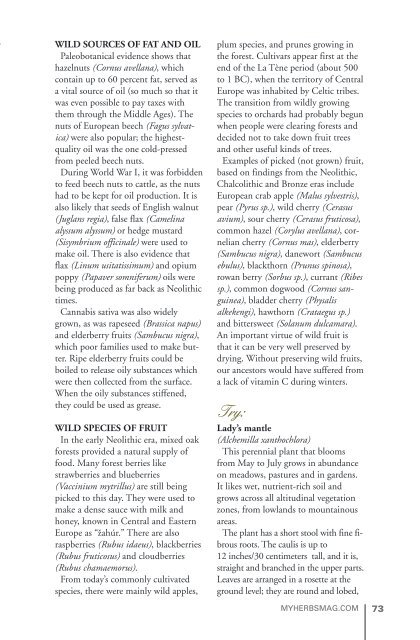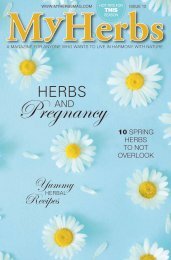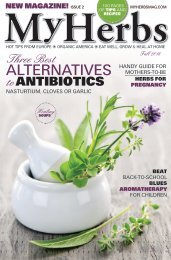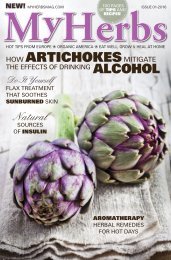My Herbs 1
Find out more on MYHERBS-STORE.COM. My Herbs is a special quarterly publication for anyone who is interested in alternative cooking, home grown herbs, and traditional or complementary medicine or healing methods, simply for everyone who wants to live in harmony with nature.
Find out more on MYHERBS-STORE.COM.
My Herbs is a special quarterly publication for anyone who is interested in alternative cooking, home grown herbs, and traditional or complementary medicine or healing methods, simply for everyone who wants to live in harmony with nature.
Create successful ePaper yourself
Turn your PDF publications into a flip-book with our unique Google optimized e-Paper software.
WILD SOURCES OF FAT AND OIL<br />
Paleobotanical evidence shows that<br />
hazelnuts (Cornus avellana), which<br />
contain up to 60 percent fat, served as<br />
a vital source of oil (so much so that it<br />
was even possible to pay taxes with<br />
them through the Middle Ages). The<br />
nuts of European beech (Fagus sylvatica)<br />
were also popular; the highestquality<br />
oil was the one cold-pressed<br />
from peeled beech nuts.<br />
During World War I, it was forbidden<br />
to feed beech nuts to cattle, as the nuts<br />
had to be kept for oil production. It is<br />
also likely that seeds of English walnut<br />
(Juglans regia), false flax (Camelina<br />
alyssum alyssum) or hedge mustard<br />
(Sisymbrium officinale) were used to<br />
make oil. There is also evidence that<br />
flax (Linum usitatissimum) and opium<br />
poppy (Papaver somniferum) oils were<br />
being produced as far back as Neolithic<br />
times.<br />
Cannabis sativa was also widely<br />
grown, as was rapeseed (Brassica napus)<br />
and elderberry fruits (Sambucus nigra),<br />
which poor families used to make butter.<br />
Ripe elderberry fruits could be<br />
boiled to release oily substances which<br />
were then collected from the surface.<br />
When the oily substances stiffened,<br />
they could be used as grease.<br />
WILD SPECIES OF FRUIT<br />
In the early Neolithic era, mixed oak<br />
forests provided a natural supply of<br />
food. Many forest berries like<br />
strawberries and blueberries<br />
(Vaccinium mytrillus) are still being<br />
picked to this day. They were used to<br />
make a dense sauce with milk and<br />
honey, known in Central and Eastern<br />
Europe as “žahúr.” There are also<br />
raspberries (Rubus idaeus), blackberries<br />
(Rubus fruticosus) and cloudberries<br />
(Rubus chamaemorus).<br />
From today’s commonly cultivated<br />
species, there were mainly wild apples,<br />
plum species, and prunes growing in<br />
the forest. Cultivars appear first at the<br />
end of the La Tène period (about 500<br />
to 1 BC), when the territory of Central<br />
Europe was inhabited by Celtic tribes.<br />
The transition from wildly growing<br />
species to orchards had probably begun<br />
when people were clearing forests and<br />
decided not to take down fruit trees<br />
and other useful kinds of trees.<br />
Examples of picked (not grown) fruit,<br />
based on findings from the Neolithic,<br />
Chalcolithic and Bronze eras include<br />
European crab apple (Malus sylvestris),<br />
pear (Pyrus sp.), wild cherry (Cerasus<br />
avium), sour cherry (Cerasus fruticosa),<br />
common hazel (Corylus avellana), cornelian<br />
cherry (Cornus mas), elderberry<br />
(Sambucus nigra), danewort (Sambucus<br />
ebulus), blackthorn (Prunus spinosa),<br />
rowan berry (Sorbus sp.), currant (Ribes<br />
sp.), common dogwood (Cornus sanguinea),<br />
bladder cherry (Physalis<br />
alkekengi), hawthorn (Crataegus sp.)<br />
and bittersweet (Solanum dulcamara).<br />
An important virtue of wild fruit is<br />
that it can be very well preserved by<br />
drying. Without preserving wild fruits,<br />
our ancestors would have suffered from<br />
a lack of vitamin C during winters.<br />
Try:<br />
Lady’s mantle<br />
(Alchemilla xanthochlora)<br />
This perennial plant that blooms<br />
from May to July grows in abundance<br />
on meadows, pastures and in gardens.<br />
It likes wet, nutrient-rich soil and<br />
grows across all altitudinal vegetation<br />
zones, from lowlands to mountainous<br />
areas.<br />
The plant has a short stool with fine fibrous<br />
roots. The caulis is up to<br />
12 inches/30 centimeters tall, and it is,<br />
straight and branched in the upper parts.<br />
Leaves are arranged in a rosette at the<br />
ground level; they are round and lobed,<br />
MYHERBSMAG.COM<br />
73












